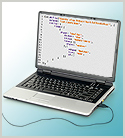Generating a Simple App - start the course
- download and install Sencha Touch along with Ruby in order to build your app
- launch Sencha Touch to generate and name a new app
- describe the file structure created when using the Sencha command to generate an app in JavaScript Sencha
- edit the app.js file to create a simple app structure for a home page
Touch Containers and Components - create a basic container
- create and add a subscriber list container to an app by using code
- use Sencha Touch to add an EventListener controller to an app
- use a component's initialize function and alias property in an app's view code
- create an app component using an alias in Javascript Sencha
Views, Models, and Data Store - render a basic list by extending the List class, creating an alias, and providing content that includes loading text, emptying text, and listing item specifications
- add a component to a container by adding a reference in the view config, and defining the view in the container
- create and name a model for an app
- add validation to a model and set its type and field
- set up and manage a data store within an existing model
- set up a store in a view by using a controller and adding specific config files to your application
Forms and LocalStorage - use Sencha Touch's configs and xtypes to customize the view and various properties for a form
- render a view with an event in another view by adding a reference to the view that will be rendered to the Controller
- fire an onListDisclose event that calls the same editor form and passes the existing data to it
- enable browser-based applications to store data locally on the user's hard drive by loading the LocalStorage class from the proxy package, and adding functionality to the Save button on an editor form
- write a save function for the Controller to transfer data from an editable form to the LocalStorage
- add an event handler to the delete button, then write a function in the Controller that calls the remove function from the Store
- configure an app's Home button to return the user to the main screen
Mobile Device Deployment and Packaging - download the Android SDK from the Android Developer's site
- install Node.js to support Apache Cordova
- enable Cordova support and configure an app
- emulate an app with Cordova
- open AVD Manager to create and set up an Android emulator in order to test a custom app
- run the Android emulator in order to install and test the functionality of an app created in Sencha
- create and edit the config.xml file of an application ready for use with PhoneGAP
- use the ConfiGAP application to create a config.xml file
- use PhoneGap Build to build an application for an Android device
|


